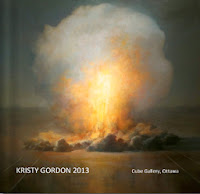 STAGE 1 Establishing the Basic Shapes
STAGE 1 Establishing the Basic ShapesI started with a general flesh colour for the face (using Cadmium Red Medium, Lemon Yellow, Ultramarine Blue, Alizarin Permanent, Gamblin’s Titanium/Zinc White Mixture, and the occasional addition of Yellow Ochre Pale and English Red), then added darks to the shadow side. At this stage, I was primarily thinking about blocking in the basic shapes, and defining the light side and the shadow side. By “drawing with the shadows,” I was able to judge the placement of everything and achieve an accurate likeness early on.
I often block in all of the background colour early on in a painting, but to achieve a more spontaneous result I limited painting in the background to only where it was absolutely necessary to describe the tones and colours of the face.
 STAGE 2 Shadow Band and Form Modeling
STAGE 2 Shadow Band and Form ModelingNext I started to darken along what some academic artists call the “terminator,” and others call the “bed-bug line.” It is the darkened band along where the light side turns into the shadows. Since reflected light bounces into the shadow side, this band is often the darkest part of the shadow. It changes with the contour of the body, becoming thicker/thinner in areas and lighter/darker in areas.
I was also thinking a lot about “big form modeling.” This means describing the larger, overall forms, such as the egg shape of the head and the cylindrical nature of the neck. Initially, his face felt too wide to me, but it kept measuring correctly. When I started to darken the edges of both the light and shadow sides, making the sides of the jaw wrap around the form, his face started to feel like it was the right proportions
 STAGE 3 Hair and Features
STAGE 3 Hair and FeaturesFor this sitting, I added the hair with my Langnickel brushes. They make really nice looking strokes! I used Burnt Sienna, Burnt Umber, Ultramarine and sometimes a little Lamp Black for the hair. As I was painting the hair, I also blocked in select areas of the background to establish that relationship.
Then I worked on the features some more, and the overall form of the face. I started to describe the planes of the forehead, and soften the hairline, as well as put a bit more information into the shadow-side. What we see in the shadow-side should normally be understated, so it’s always a balance between selection and elimination with the shadow-side.
 STAGE 4 Background and Shirt Block In
STAGE 4 Background and Shirt Block InI blocked in a loose background, in a very direct fashion, with my 1” Langnickel brush, and tried not to mess with it. I wasn’t sure at first if I would leave it like this or work with it more later (which I did end up doing). I also started to block in the placement of the shirt. I really wanted to keep the painting of the shirt loose and direct, so I didn’t take it too far at this stage. I wanted to have a couple days to think about it before really going in there with it.
 STAGE 5 Defining the Background and Shirt
STAGE 5 Defining the Background and ShirtFirst I went in and defined the shirt, squinting my eyes a lot to really see how the colours and tones changes across his chest.
I noticed that in the last stage the brushstrokes were too distracting and the background was too light, both of these factors were making it hard to know where to rest the eyes, which was supposed to be on the light side of his face! So, one night, in-between session, I went in with a palette knife and blocked in this new background. I wanted to keep some ares transparent and textured, and I found that the palette knife, along with the fairly transparent colours I had selected worked well for that. I was using Ultramarine, and Burnt Sienna with Galkyd and linseed oil as the base, and was tinting it with black, and Yellow Ochre and English Red as needed to achieve variation in the colours an the shadow pattern around his head.
 STAGE 6
STAGE 6 Refinements
I continued to define the the face and hair, leaving the background and shirt alone for a while. In the face I focused particular attention on the area in the light. In paintings, the light is supposed to define the form, and the shadows give atmosphere, and can be used to create interesting shadows around the lights. So I really focused most of my attention on the light side of his face. Most of the refinements were very subtle at this stage, but in particular you can more definition of the cheekbone and the softening of the hairline in the light.
 STAGE 7
STAGE 7 Final Adjustments
The forehead was a real challenge in this one. I had noticed when I turned the painting upside down that the shadow on the top of his forehead wasn’t blending into the light side properly, and also that the form didn’t feel right in the light side of his forehead either. So I softened the shadow-line and really evaluated the planes of his forehead.
 STAGE 8
STAGE 8Finishing Details
I wanted the highlights to seem loose but accurate. Also, I really like it when the lightest parts of a painting are thicker and textured, so I kept trying to put on nice thick highlights, scraping it off and trying again, until finally I liked the way the brushwork in the forehead was working.
Here's a video of me working on the painting around stages 3 and 4.
Cinematography by Mike Kerr and Nick Cross
Editing by Nick Cross
Music by Patrick Metzger
(I'm the luckiest person in the world to have so many talented friends!! Thanks guys!!)













